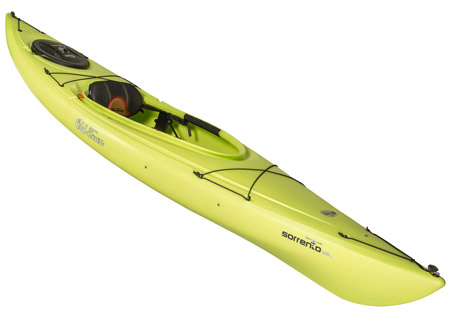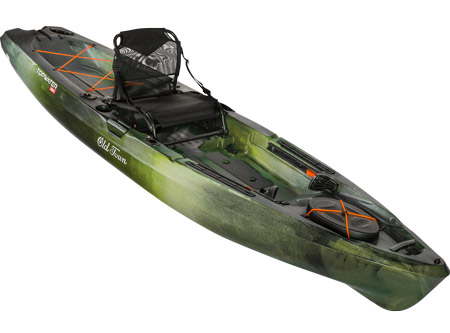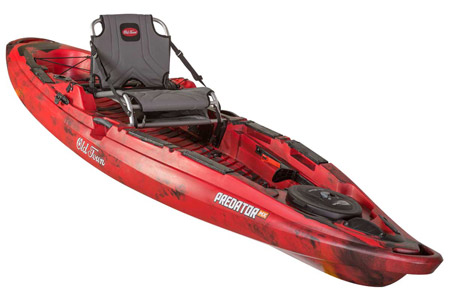Choosing the Best River Kayak in 2020
River kayaking is a popular activity for those who like to mix it up with adventure, recreation, family outings and fishing or hunting trips. Whether floating along enjoying the quiet and blue skies or casting a line into rushing water, you need to know which kayak will do the job.
Kayaking is a far more accessible activity than images depicting drops down raging waterfalls would suggest. Rivers are often associated with heart-pounding whitewater; however, most river trips offer a mix of currents. Typically, paddling down a river means stretches of flat water, punctuated by class I and II rapids that don’t require a customized or sport kayak.
It can be challenging to pick just one river kayak, especially if you are new to the sport and aren’t certain how you’ll use your new boat. We’ve chosen three categories to consider:
- River recreational
- River fishing
- Mixed use
We discuss features to look for in all-around kayaks for “recreation” and profile two sportsman models that borrow the best from canoeing.
Kayaks come in two distinct styles: sit-on-top and sit-inside. Some paddlers prefer the dry, secure feeling of sit-insides, while others like the easy-access benefit of sit-on-tops (and don’t mind getting a bit wet). We recommend comparing the advantages of each style. Beyond that divide, there are tandem or solo boats, and specialized watercraft for oceans (sea kayaks) or whitewater (sport kayaks). The waters get muddied in picking the best river kayak, however, so it’s helpful to compare size, features and specifications.
BEST RIVER KAYAK FOR RECREATION
Novice kayakers and non-adrenaline junkies will find plenty of adventure in rivers with swift currents, riffles (a shallow or rocky part of a stream), and ever-changing conditions. Rapids up to class III are manageable for paddlers using a longer, stable boat or one short enough to turn on a dime. We recommend several kayaks that can handle up to class II--even class III, with paddling experience--but beyond that, a specialized sport kayak and training are recommended.
A quick review of rapids is helpful here. In rivers, the scale is from class I (flat water with a current or riffle, no obstacles), class II (larger but regular waves, clear channels), class III (larger waves, necessity to maneuver and/or narrow channels). Class IV and V (require precise paddling, may have large drops). Class VI rapids are the stuff of National Geographic expeditions.
It’s prudent to go beyond the “starter kayak” for river trips and set your sights above cheaper boats. Most starter kayaks found in the recreational class are difficult to maneuver due to poor tracking and lack the stability needed in rapids and changing currents.
If you kayak for the scenery, fun and family bonding and love a freewheeling day trip, the Sorrento sit inside is an excellent kayak for river use. It fits squarely into the recreational kayak category, yet it is high quality and comfortable enough to where you may never need to upgrade to a more expensive model. The reason the Sorrento is a crowd-pleaser lies in its combo of useful features, retractable rudder, and sleek, yet stable design.

The Sorrento models have a unique feature specifically designed for rivers that can’t be found on lower-end recreational kayaks. A convenient handle next to the seat releases a skeg (or rudder) under the boat’s rear, which helps the kayak maintain a straight line while paddling in windy conditions or in current. In shallower waters, the skeg can be retracted with an easy flip of a handle. That means the Sorrento is versatile enough to handle any water depth in the river, navigating currents and obstacles with ease, comfort and confidence.
The Sorrento is user-friendly, and to add to its versatility, it comes in two sizes: Sorrento 106sk for smaller paddlers, and the Sorrento 126sk for the taller set.
In swifter rivers, the shorter Sorrento 106sk version (10’ 3”) handles wonderfully. Because the paddler is seated low in the water, the experience in fast water is closer to a sport kayak. The generous cockpit allows for easy entry and exit, but a moderate beam of 29” means most paddlers can use a shorter paddle for more control.
The longer overall length (12’6”) along with the rudder, makes the Sorrento 126sk a superior tracking kayak that is very efficient to paddle. Taller paddlers are provided excellent leg room; and, the 28.5 inch beam means a kayaker with a longer paddle can make excellent time over distances. Sorrento models also include the superior ACS2 seat, a far more comfortable option than other kayaks in this class provide.
RIVER KAYAKING FOR FUN AND FUNCTION
Kayaks are, by many measures, built for rivers. Sit inside or on top? Lightweight or feature-heavy? Your best boat is one that combines several features you will use and offers a satisfying experience from day one.
Since a kayak is an investment that can last for years or even decades, and where you will kayak is a big part of decision-making, it’s wise to define your needs before you steer your money toward a new boat.
For some paddlers, the next dilemma when considering river kayaking is: sit inside or sit on top? We recommend considering the benefits and limitations of both styles. For anglers, the sit on top approach is an incredibly stable, storage-friendly river fishing kayak.
Deciding on the right boat for fishing or hunting is more straightforward, especially since the line of kayaks available for storage and stealth is so impressive.
Whichever way you decide to go, your knowledge of what’s out there begins with understanding that a great river kayak will roll with the rapids and glide through calm waters.
Longer and heavier kayaks can work well for river running. Both Sorrento sizes can negotiate class I and II rapids with ease, and class III with proper training and experience. Both are stable in fast water.
Weight matters in river kayaks, because you’ll need to store, transport by vehicle, and sometimes even portage. At 45 pounds, most paddlers can tote the smaller Sorrento far enough to reach the river put-in and carry it back to the car at day’s end. The larger Sorrento weighs 56 pounds, so you may need a partner to assist with the on-land transportation from car top to shoreline and back.
The Sorrento is a good substitute for touring kayaks on multi-day river trips, providing generous rear hatches. Sorrento uses Click Seal technology to keep gear dry and can store enough gear for an overnight. For all-purpose river fun these boats shine on day trips in a variety of still water, current, riffles, and whitewater—the perfect kayak for a float and paddle adventure.
Buyers will note the price difference: recreational or “starter” kayaks begin in the $400 to $500 price range, while Sorrento river kayaks start at $800. Most buyers base their decision on features, style, and overall versatility for river use. Beware of the sub $400 models selling at many discounters these days, while a $200 kayak may be all you need to paddle for very short times near shore, these “play boats” not only lack the design functionality you need on the river, they can be tough to handle on longer excursions due to rougher glides and steering.
With a nimble enough design to maneuver with grace in class I - III rapids but keep a steady line and pace in calm waters, recreational river kayaks must hit a lot of high notes. The secret weapon in recreational river kayaks is a way to keep the boat going straight and swift in flat water. For this reason, the retractable skeg, which boosts performance, is a serious consideration.
BEST RIVER FISHING KAYAK
For anglers, kayak options have exploded in the last decade. Both new materials and design innovations have improved the range of kayaks for fishermen and women. In the past, paddlers fished from their recreational sit-in kayaks, adapting them to their needs. Manufacturers took this que and started to provide amenities like rod holders.
Today, there are kayaks designed specifically for kayak anglers - wide, flat, sit-on-top designs have become the most popular. For river fishing, the Topwater 120 offers an ultra-stable DoubleU hull that glides through river conditions and provides a stand-up platform for casting.

Essentials like tackle storage, rod holders, accessory mounts and a universal transducer mount for easy installation of a fish finder make the Topwater 120 a fishing machine. A bow hatch provides dry storage, while the open tank well in the rear is a perfect spot for your fishing crate.
The wide, flat deck allows a larger, more comfortable seat to be used. As the name suggests, the ElementAir seat on the Topwater 120 incorporates mesh for air circulation and can be utilized in a high or low position. The high position is easier to sit and stand from; while the lower position is easier for paddling.
Conveniences like a cup holder and paddle storage are the not-so-small details that make the Topwater 120 a fun fishing rig.
BEST MULTI-USE RIVER KAYAK
The ideal mixed-use kayak is maneuverable, practical, and won’t slow you down to a crawl on long flat water – and it should outperform most traditional canoes for fishing and hunting.
The challenge for anglers and hunters paddling in a mix of currents and conditions is to have a boat wide enough to work as a stable platform but compact enough to steer through currents, eddies and swifter water. Mixed-use river kayaks should also allow paddlers to camp and haul gear, so they need storage space.
The Predator MX Angler can handle a wide range of conditions, has loads of storage, and makes a great river fishing kayak. The Predator line comes in several varieties but for versatility and river handling we’ve chosen the MX (“mixed conditions”) model.

The moderate length (12’) and a wide beam (34”) allows the Predator MX Angler to track well; its stability as a platform for casting is excellent, and it offers several other design innovations in a larger, feature-rich fishing kayak. We cover more of the features of the Predator MX in the next section.
Inflatable kayaks are an example of another multi-use boat. They excel in transport and versatility; however, handling doesn’t compare with the Predator and in flat water, even with dual skegs, inflatable river kayaks lose speed fast.
The Discovery 119 Solo Sportsman from Old Town is a great example of a hybrid river craft that offers every necessary feature to hunt, fish, transport, and paddle. The 119 Solo Sportsman offers the roominess of a canoe with an ultra-lightweight and durable hull, hence its “solo” moniker because it can be portaged, unloaded and re-loaded without extra help.
This boat design isn’t new—it’s been a bestseller for years in the world of outdoor purists and fishermen—but it continues to get upgrades and added features as it climbs into the hybridization stratosphere to near-perfection. This is a canoe that incorporates the best of kayaking.
The hybrid style, when it’s done right, incorporates four key kayak features. First, like their sit on top kayak counterparts, hybrids are stable, making entry/egress smooth. Second, they glide over obstacles and in shallow waters, where a traditional canoe might get hung up. Third, crossovers travel well: from car top or trailer, whether hauled on two wheels or carried with one arm—they make great companions for solitary adventures.
And, finally, the paddler sits relatively low in the water and uses a twin-bladed paddle and footrests for efficient, strong strokes. In other words, they are efficient to paddle.
The Discovery 119 Solo Sportsman optimizes canoe features with an open, modular design to store tackle crates, decoy bags or other gear; and, plenty of space for a dog. Overall length is 11 feet, 9 inches with a 32 ½ inch beam, and weight is only 56 pounds. The kayak-style seat is set back slightly from center to augment overall stability and create excellent paddling position. Padding and an adjustable back combine for comfort uncommon in canoe seating.
These boats are space maximizers. On the Discovery 119 Solo Sportsman, for example, padded arm rests flank each side of the seat with trays that can hold lures, shotgun shells and tools, as well as a spot to prop a rod while you change out lures. The forward thwart has a gear track mount for securing fish finders, cameras, anchor kits etc. and the rear thwart features flush mounted rod holders.
Most fishing kayaks suitable for fishing rivers are between 12’ and 14’ long or more, to allow for plenty of storage space, a wide enough beam to make a stable boat, and enough length to glide efficiently over flat water.
Well-built fishing kayaks for river trips should include all the little extras: cupholder, grab-and-go molded handles at front and rear, adjustable foot braces, and a padded seat that will raise your standards for comfortable fishing.
MANEUVERING ON RIVERS
Boat design is an important factor to consider when you’re thinking about maneuvering on rivers. The Predator MX Angler design incorporates a performance tri hull with a rounded shape to adapt to currents, eddies and changing conditions. This feature sets it apart from other fishing kayaks.
The Predator MX Angler also blends in features to create a highly stable platform. The deck is built with ridged, slip-resistant Exo-Ridge technology. For additional support, a stand-up assist strap can be used. Its wide beam design minimizes wobble and sway. It glides and tracks in water due to its length and performance crafting but has multiple features for placing tackle, storing rods and paddle, stowing gear, and mounting accessories. The Element Seating system rivals many living room loungers in comfort and provides excellent back support with 15 inches of height.
In addition to a sealable (Click Seal) front storage hatch, the Predator MX Angler includes a recessed bow hatch with bungee cords, dual side tackle holders and side rod bungees. It’s ready for your accessories or for securing nearly any item with six removable mounting plates found throughout the boat.
It seems as if the Predator MX Angler has left no feature behind; the standard scupper plugs and rear and side molded handles are not forgotten. It also has an adjustable foot peg system tucked in up front. With all these features comes a bit more weight than some other kayak models. At 82 pounds, it can be carried short distances to the water by some paddlers, however, a two-wheeled kayak carrier makes hauling super easy.
Who uses this type of boat, and who will love it? For serious fishermen and hunters who are bound to encounter swift water and want a floating platform with maximum stability and impressive capacity, the Predator MX Angler can’t be beat. Smaller paddlers who don’t want the heft of this boat or who won’t fish more than once or twice a year will prefer a lighter weight hybrid river kayak such as the Discovery Solo 119 Sportsman.
A RIVER KAYAK FOR YOU
Whether you want to drift down, a lazy river, shoot down the rapids, fish or hunt, there is a kayak perfectly suited to your needs. Finding the best one is really just a matter of knowing what you want to do. For more information about Old Town’s kayaks feel fre to check out our buying guide.